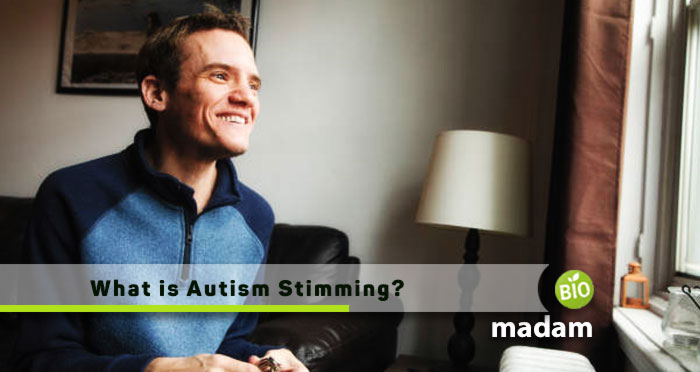What is the Meaning of Stimming? Self-stimulatory behavior is also known as stimming and self-stimulation. Stimming or stims is the repetition of physical movements, sounds, or repetitive movements of objects every day in individuals exposed to stress or anxiety. For example, people with autism may exhibit stimming when overloaded with a high level of anxiety.
Hand flapping, rocking, vocalization, or repetitive movements in autistic children may confuse many neurotypicals who want to control such behavior in people with an autism spectrum disorder. These stimming behaviors look strange and dangerous to the rest of us, but these behaviors really serve a purpose for people with ASD.
Is Stimming Always Related to Autism?
Self-Stimulating behaviors like repetitive movements or sounds are referred to as stimming. Stimming is expected somehow, but it is an integral part of the diagnostic criteria of Autism Spectrum Disorder.

Types of Common Stimming
Common stimming behaviors you can observe in people or yourself include:
- Biting their fingernails
- Take out hair and twirl flick of hair around their finger again and again
- Cracking their knuckles or other joints of fingers and toes
- Making sound by drumming their fingers
- Jiggling their foot for an extended period
- Whistling or vocalization
Types of ASD Stimming Behaviors
- Rocking
- Flapping hands again (hand flapping Aspergers)
- Flicking or snapping fingers (autism finger flicking)
- Bouncing, jumping, or twirling without observing any obstacle
- Pacing or walking on tiptoes (strange hand and body movement)
- Pulling hair forcefully
- Repeating words or phrases
- Rubbing the skin or scratching
- Repetitive blinking
- Staring at lights or rotating objects such as ceiling fans
- Licking, rubbing, or stroking particular types of objects
- Sniffing at people or objects
- Rearranging objects
Children with autism can spend hours arranging their toys. They do not pay their time playing with their toys; instead, they love to organize their toys.
There is a list of other repetitive behaviors in autistic children that can really cause physical harm like:
- Headbanging
- Start punching or start biting to themselves or others
- Non-edible swallow items that can put their lives in danger
How to Reduce Stimming Behaviors Autism?
Stimming is favorable to some extent, but most of the stimming behaviors are dangerous for the life of an autistic child. Therefore, it is imperative to help autistic people to improve their quality of life. Two main techniques can gently help a person who engages in harmful stimming; one removes the cause and the second redirects to something less destructive.
Remove the stimulator/cause
When stimming behavior starts, look for the stimulator. The problem stimulator that causes stress must be removed pre-emptively before the stress becomes overloaded.
Redirect the Stimming Behavior to something less harmful
If you can’t remove the stressor or are unable to identify the stimulator, then see if you can redirect the person to a less harmful comfort stim, like holding an ice cube or letting them draw a paper with a pencil.
Autism Stimming Example (Fathering Autism)
So I have a girl who has a lot of stems or stemming behavior.
What is Autism Stemming?
Self-stimulatory behavior, also known as stemming and self-stimulation, is the repetition of bodily movements, sounds, or repetitive objects every day in individuals with developmental disabilities, but most prevalent in people with autistic spectrum disorders.
Basically, it’s a way in which people with autism calm or stimulate themselves. Similarly, my girl has a lot of stems, and they change constantly. So we took a very scientific approach to it as a family. We wanted to really dig deep into what these stems do for her. I’m totally lying. We pretty much just reenacted the stimming tried to see what she got out of it. Not very scientific at all; there’s no science.
There’s a whole lot of science behind autism stemming. I could do multiple videos on stemming, and several books are written about stemming. We don’t. I’m for those of you who don’t know us. Please understand there’s a big difference between making fun of and having fun.

We celebrate it and have fun with it; we would like you to enjoy it as well, and we make fun of neurotypical people a lot. So why treat Angel, my girl, any different. We’re just going to try out some autism stimming behaviors. Twisting five-o, both of them are too simplistic. So it’s got a neat piano. Yeah, it does. It’s like you’re doing this. Thank you, lady, you can do it. You get down there, whoo I’m close your head back and forth. Why is your foot trembling? Does it hurt? It is a good night that is fine. Whatsoever that’s just a painful way for some face hugs, no game at all, god.
They’re so much bigger than her. I totally get it, and I’m very calm right now. I’m not that fantastic, and I feel stressed out right now. This one feels better because it has a little sound to it. It’s got a little pop. I feel like I’m doing a beat, but his ears are just floppy flesh some Africa.
What Do You Think About Stemming Behavior?
Thanks, think for the insight. What do you feel? You feel more comfortable, not at all. I don’t understand that one, and not at all okay. So what do you think? Uh, I don’t know what the grunting thing is; blinking feels weird. I think she does the grunting for her throat. Yeah, but it doesn’t do anything to me. Nope, your stimming exhaust me. Yeah, I feel better, joy that. I really feel like I am empowered right now. We go like I just got a bunch out like a breath of fresh air. Sure, as a family, we cherish the things that make Abigail unique. We love the things that make her different, and Fraga’s guilt it’s really a part of who she is.
Point to Ponder
People with stimming should be helped through a gentle approach. The smooth process will increase the chances of empowerment for both the person trying to help and the person who requires help to stop harmful behaviors.

Hi, my name is Eva. I am currently practicing as a clinical social worker, that being my childhood desire. As a licensed therapist holding MPhil in Clinical Psychology, I am now on biomadam to provide the natives with the best family advice! Do you have any questions? See you in the comment section.

